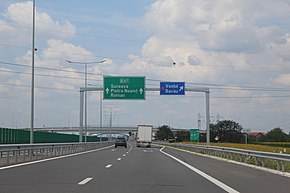Our website is made possible by displaying online advertisements to our visitors.
Please consider supporting us by disabling your ad blocker.
A7 motorway (Romania)
| A7 motorway | ||||
|---|---|---|---|---|
 The A7 motorway's planned route as of 2022 | ||||
 Interchange with the DN2F at Holt, east of Bacău | ||||
| Route information | ||||
| Maintained by Compania Națională de Administrare a Infrastructurii Rutiere | ||||
| Length | 115.1 km (71.5 mi) 453.3 km (281.7 mi) planned 308.045 km (191.410 mi) under construction 61.971 km (38.507 mi) tendered 56.076 km (34.844 mi) under design | |||
| Existed | 2020–present | |||
| Major junctions | ||||
| South end | ||||
| North end | ||||
| Location | ||||
| Country | Romania | |||
| Counties | Prahova, Buzău, Vrancea, Bacău, Neamț, Iași, Suceava | |||
| Major cities | Ploiești, Buzău, Focșani, Bacău, Roman, Pașcani, Suceava | |||
| Highway system | ||||
| ||||
The A7 motorway (Romanian: Autostrada A7),[1] also known as the Ploiești–Siret Motorway (Romanian: Autostrada Ploiești–Siret) or the Moldavia Motorway (Romanian: Autostrada Moldovei),[2] is a partially built motorway in Romania, that upon completion will link Ploiești to the north-eastern part of the country, partly along the Pan-European Corridor IX. It will run along the route: Buzău, Focșani, Bacău, Roman, Pașcani, and Suceava, connecting to Ukraine's M19 highway near Siret.[3]
As of 25 December 2024, 5 segments of the motorway are done, totaling to 115.1 km of opened motorway. All other sections of the motorway are in various stages of planning, tendering, and construction.
The Pașcani – Siret section will be financed through EU funds, while the government wants the Ploiești – Pașcani section (excluding the Bacău bypass) to be financed through the Romanian PNRR (short for Planul Național de Redresare și Reziliență, part of the Next Generation EU package).[4][2]
- ^ "Autostrada A7 Ploiesti - Pascani". 130km.ro. Retrieved 3 December 2020.
- ^ a b "Drulă: Centura Bacăului, parte din A7 - Autostrada Moldovei, va fi dată în folosinţă integral în perioada imediat următoare" (in Romanian). Digi24. 24 June 2021. Retrieved 2021-06-30.
- ^ "HARTĂ INTERACTIVĂ Autostrada "Moldovei" A7 Pașcani - Suceava - Siret: Variantele de traseu analizate oficial" (in Romanian). HotNews.ro. 20 April 2021. Retrieved 2021-05-11.
- ^ "Florin Cîțu, despre autostrada A7 Pașcani - Suceava - Siret: "Avem traseul final, va fi autostradă nu drum expres"". HotNews.ro (in Romanian). 14 May 2021. Retrieved 2021-06-30.
Previous Page Next Page



